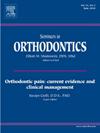The design of bone-borne maxillary expander affects the different dentoalveolar inclination and expansion pattern: A CBCT study
IF 2.2
4区 医学
Q2 DENTISTRY, ORAL SURGERY & MEDICINE
引用次数: 0
Abstract
Objective
This study compared the skeletal and dentoalveolar changes induced by tissue-bone-borne expander (C-expander) and pure-bone-borne expander (ATOZ-expander) using CBCT analysis. We aimed to identify their distinct expansion patterns and potential clinical implications.
Materials and Methods
A total of 60 subjects, comprising 14 males and 46 females with an average age of 18.5 ± 7.36 years, were divided into two groups: the tissue-bone-borne expander group (CEXP group, N = 30, average age 19.16 ± 7.09 years) and the pure-bone-borne expander group (ATOZ group, N = 30, average age 17.83 ± 7.56 years). CBCT scans were obtained before (T1) and after expansion (T2). Zygomatic, palatal, and dentoalveolar dimensions were measured and analyzed using paired T-tests and Kruskal-Wallis tests.
Results
The CEXP group demonstrated significantly greater dental expansion and an increase in dentoalveolar inclination. In contrast, the ATOZ group exhibited significantly less zygomatic expansion and a decrease in dentoalveolar inclination. In horizontal plane, the CEXP group showed more parallel expansion pattern than the ATOZ group. Both groups showed similar amount of palatal expansion.
Conclusion
The tissue-bone-borne C-expander demonstrated more pronounced dentoalveolar effects with a vertically pyramidal and sagittally parallel pattern of expansion. In contrast, the pure bone-borne ATOZ-expander exhibited more substantial skeletal effects with a vertically parallel and sagittally trapezoid expansion.
骨性上颌扩张器的设计会影响不同的牙槽倾角和扩张模式:CBCT 研究
目的应用CBCT分析比较组织骨扩张器(C-expander)和纯骨扩张器(ataz -expander)对骨和牙槽骨的影响。我们的目的是确定其独特的扩张模式和潜在的临床意义。材料与方法60例患者,男14例,女46例,平均年龄18.5±7.36岁,分为组织骨载扩张器组(CEXP组,N = 30,平均年龄19.16±7.09岁)和纯骨载扩张器组(ATOZ组,N = 30,平均年龄17.83±7.56岁)。ct扫描分别在扩张前(T1)和扩张后(T2)进行。使用配对t检验和Kruskal-Wallis检验测量和分析颧骨、腭和牙槽尺寸。结果CEXP组牙扩展明显增大,牙槽倾角明显增加。相比之下,ATOZ组表现出明显较少的颧骨扩张和牙槽倾角下降。在水平面上,CEXP组比ATOZ组表现出更多的平行扩张模式。两组的腭扩张量相近。结论组织骨运载的c型扩张器对牙槽的影响更明显,呈垂直锥体和矢状平行扩张。相比之下,纯骨载atoz -扩张器表现出更实质性的骨骼效应,具有垂直平行和矢状梯形扩张。
本文章由计算机程序翻译,如有差异,请以英文原文为准。
求助全文
约1分钟内获得全文
求助全文
来源期刊

Seminars in Orthodontics
DENTISTRY, ORAL SURGERY & MEDICINE-
CiteScore
2.20
自引率
4.80%
发文量
28
审稿时长
10 days
期刊介绍:
Each issue provides up-to-date, state-of-the-art information on a single topic in orthodontics. Readers are kept abreast of the latest innovations, research findings, clinical applications and clinical methods. Collection of the issues will provide invaluable reference material for present and future review.
 求助内容:
求助内容: 应助结果提醒方式:
应助结果提醒方式:


